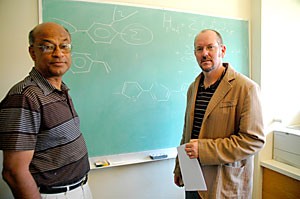Thousands, maybe even millions of them are inside every different kind of electronic device. They are in iPods, cell phones, even the central processors of laptops.
For about 60 years, they have been inside electronics, acting as an electrical switch with no mechanical component. They vary in size from the tip of a finger to smaller than the head of a pin, controlling the flow of electrical current.
“”Every electrical circuit requires control, and transistors are the elements that provide control,”” said Charles Stafford, an associate professor of physics. “”Anything like a shower, you would need to control whether the water is flowing or not, so in the same way the electrical current needs to be controlled as well.””
But as with new advances in technology, the 60-year-old transistor is getting revamped.
Imagine a new iPod that uses transistors the size of a molecule to control the flow of current. With the flow of current controlled by molecule-sized transistors, an iPod could have a terabyte of memory – equal to 1,000 gigabytes of memory.
Stafford, Sumit Mazumdar, a professor in optical sciences and physics, and David Cardamone, a 2005 UA doctoral graduate, collaborated to create a device that would turn a molecule into a transistor.
The device is called the Quantum Interference Effect Transistor, also known as the “”QuIET,”” and what started as a matter of scientific curiosity turned into a unique project and device concept that could be better than anything anyone had proposed before, Stafford said.
“”The device turns a molecule into a transistor, and the molecule-sized transistor would function in the same way as a normal-sized transistor,”” Mazumdar said.
The molecule chosen for the device was benzene, because the ring-like molecule would allow electron waves to take two paths that would interfere, Stafford said.
There would be two wires to carry the current and one wire to control the current, Stafford said, but there hasn’t been much progress in attaching the third wire to the molecule.
“”One of two things, or both, would have to happen,”” Mazumdar said. “”Find something larger than the molecule such that we can attach the connections. The other is modifying the wires themselves so that they don’t have to be the conventional kind of electrodes we have been attaching.””
Today, transistors can be as small as 65 nanometers. UA scientists are looking to shrink down the current-sized transistor to as small as a single nanometer, about one-billionth of a meter.
Mazumdar said computer processing has made it possible to place millions of molecule-sized transistors in a tiny space and that these transistors are the next step in the process of miniaturization.
“”If you look at the first computer ever made, it was like a giant hall full of vacuum tubes basically serving the same function as a transistor, and the computational power of that computer was so limited that probably the processor of a cell phone is more powerful,”” Stafford said.
Implementing the molecule-sized transistor is still in the conceptual phase, Mazumdar said, but there are theoretical models that would simulate a molecular device.
Stafford and Mazumdar submitted their patent request for their invention on March 20, about two years after the initial disclosure of the invention when Cardamone gave a scientific talk at an American Physical Society meeting.
“”This is kind of leap-frogging ahead to the ultimate limit of miniaturization,”” Stafford said. “”Miniaturization that has been proceeding continuously since the ’40s – right now state-of-the-art devices are at about 60 nanometers, our transistor is less than 1 nanometer, basically as small as you can get.””
The research involved in creating the device involved the collaboration of a variety of different science disciplines.
“”It is really at the intersection of two or more different sciences,”” Stafford said. “”One is chemistry, because the molecule is understood in quantum chemistry, and the other theoretical physics.””
One of the biggest impacts the device would have should it be implemented, Stafford said, would be on the technology field.
“”It would increase the device density, enhance memory capacity so instead of a several gigabyte memory it would be a terabyte,”” Stafford said.
Though they have started the patent process, Mazumdar said research will continue.
“”This is a continuous thing, this whole aspect of research is not something you get into and you work very hard for five days and one morning you’re done. It’s our life; it’s our profession,”” Mazumdar said.
But there was also something special about the results of the project.
“”We didn’t anticipate, and in the early stages of the research, didn’t fully appreciate, how unique the device was until after the first step of the project was completed that we saw this was something really amazing that we stumbled upon,”” Stafford said.









